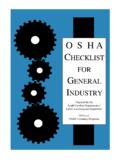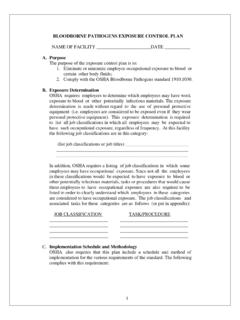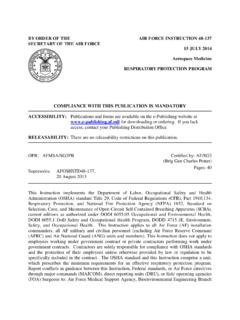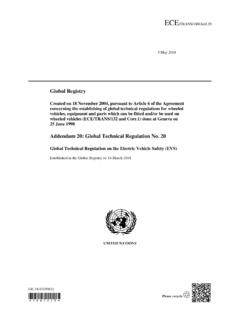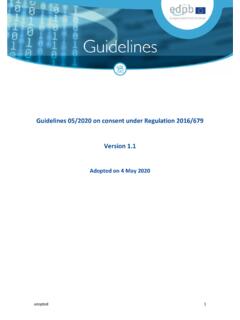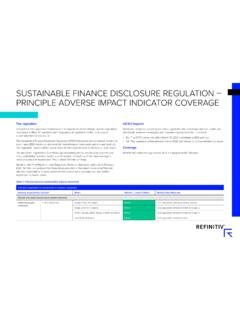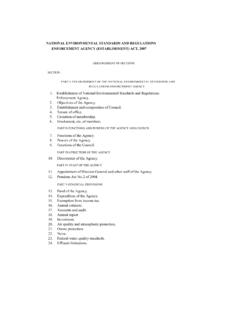Transcription of OSHA CHECKLIST FOR THE CONSTRUCTION INDUSTRY
1 OSHA CHECKLIST FOR THE CONSTRUCTION INDUSTRY South Carolina Department of Labor, Licensing and Regulation Office of OSHA Voluntary Programs 110 Centerview Drive, Post Office Box 11329 Columbia, SC 29211 (803) 896-7744 Foreword This CHECKLIST has been compiled to aid those employers and employees who seek to comply with the Rules and Regulations of the Occupational Safety and Health Act. The standards referred to are South Carolina s Occupational Safety and Health Standards for the CONSTRUCTION INDUSTRY , as adopted from 29 CFR (Code of Federal Regulations) Part 1926, under authority of the South Carolina Code of Laws (1976) as amended, Section 41-15-210, and other selected General INDUSTRY Safety and Health Standards (Article VI, Part 1910) having applicability to CONSTRUCTION work. Pursuant to this authority, the Director of Labor, Licensing and Regulation has put into force and made public certain Occupational Safety and Health Standards, which are identical to those enforced by the Secretary of Labor, United States Department of Labor.
2 These standards are known as the Occupational Safety and Health Rules and Regulations of the State of South Carolina and have been republished as Article VI and VII. The objective of this CHECKLIST is to make employers and employees aware of many of the factors to be considered when CONSTRUCTION work is done. This book is only a guide and does not necessarily assure that all standards have been complied with. The CHECKLIST is designed in such a manner that a negative answer to any question indicates an area of safety concern. If by using this questionnaire, you determine that a problem exists, or if a question of concern should arise please contact: Office of OSHA Voluntary Programs South Carolina Department of Labor, Licensing and Regulation 110 Centerview Drive Box 11329 Columbia, South Carolina 29211-1329 (803) 896-7744 Fax: (803) 896-7750 The Office of OSHA Voluntary Programs conducts safety and health training programs and seminars at plant sites throughout South Carolina at no cost to employers.
3 If you would like a list of programs, materials, and other training information please visit our website: 3 Index Page Administrative Requirements (SCRR Article 1 Sub articles III and V) 4 General Safety and Health 4 Occupational Health and Environmental Controls 5 Personal Protective Equipment and Life Saving Equipment 8 Fire protection 9 Signs, Signals and Barricades 9 Materials Handling, Storage, Use and Disposal 10 Tools, Hand and Power 11 Welding and Cutting 12 Electrical 13 Scaffolding 14 Fall protection 15 Cranes, Derricks, 16 Hoists, Elevators, and Conveyors 17 Motor Vehicles, Mechanized Equipment 18 Excavations 19 Concrete and Masonry CONSTRUCTION 19 Steel Erection 20 Underground CONSTRUCTION , Caissons, Cofferdams, and Compressed Air 21 Demolition 22 Blasting and Explosives 22 Power Transmission and Distribution 23 Rollover Protective Structures (ROPS).
4 Overhead protection 23 Stairways and Ladders 24 Toxic and Hazardous Substances 25 Points of Contact 27 4 CHECKLIST for the CONSTRUCTION INDUSTRY Administrative Requirements SC Rules & Regulations Article I, Subarticles III and V ITEM YES NO OSHA Form 300: Are occupational deaths, injuries and illnesses recorded and reported as required? (Article I, Subarticle III, Section 302) OSHA Form 300A: Is the annual summary portion of the OSHA 300 completed by February 1? Is the summary posted from February 1 through April 30? (Article I, Subarticle III, Section 305) OSHA Form 301 or other records with same information as OSHA Form 301: Is a supplementary individual record of each occupational injury and illness completed within 7 calendar days after a case occurs? (Article I, Subarticle III, Section 304) Is the Department of Labor, Licensing and Regulation (LLR) poster SCLD-5-SH Safety and Health protection on the Job posted in a conspicuous place?
5 (Article I, Subarticle V, Section 502A) Is SC OSHA notified within eight hours of any employment fatality or accident which results in in-patient hospitalization of three or more employees? (Article I, Subarticle III, Section 308) General Safety and Health Provisions ITEM YES NO Safety and Training Education: Is each employee instructed in the recognition and avoidance of unsafe conditions and the regulations applicable to his work environment to control or eliminate any hazards or other exposure to illness or injury? (b)(2) Are employees who are required to handle or use poisons, caustics, and other harmful substances instructed in their safe handling and use, and made aware of the potential hazards, personal hygiene, and personal protective measures? (b)(3) Are employees who are required to enter confined or enclosed spaces instructed as to the nature of the hazards involved, the necessary precautions to be taken, and in the use of protective and emergency equipment?
6 (b)(6)(i) Housekeeping: Is form and scrap lumber with protruding nails and all other debris kept cleared from work areas, passageways, and stairs? (a) Personal Protective Equipment: Are employees required to wear appropriate personal protective equipment when there is an exposure to hazardous conditions? (a) For assistance in training and consultation in the recognition, avoidance, and prevention of unsafe conditions, contact the South Carolina Department of Labor, Licensing and Regulation, Office of OSHA Voluntary Programs, Post Office Box 11329, Columbia, South Carolina, 29211-1329, (803) 896-7744. 5 Occupational Health and Environmental Controls ITEM YES NO Medical Services and First Aid: Where life threatening injuries could occur, is a facility for the treatment of injured employees located within three minutes of the jobsite? If not, is there an employee(s) trained in first aid at the site? (c) Are telephone numbers of physicians, hospitals, or ambulances conspicuously posted?
7 (f) Sanitation: Are potable (drinking) water and adequate toilet facilities available at the jobsite? Occupational Noise Exposure: Are the regulations concerning protection of employees against the effects of noise exposure understood and complied with? Gases, Vapors, Fumes, Dusts, and Mists: Does the employer assure that no employee is exposed to inhalation, ingestion, skin absorption, or contact with any material or substance at a concentration above those specified in the Threshold Limit Values of Airborne Contaminants for 1970 of the American Conference of Governmental Industrial Hygienists? (a) Illumination: Are employees provided with light not less than the minimum illumination intensities listed in Table D-3 while any work is in progress? (a) Ventilation: Does the employer ensure that concentrations of hazardous substances such as dusts, fumes, mists, vapors, or gases produced in the course of CONSTRUCTION work does not exceed the limits specified in (a)?
8 (a) Hazard Communication: Does the employer have any hazardous materials on site? If so: Does employer have a written Hazard Communication Program? (e)(1) Does employer have a complete list of hazardous chemicals used on site at the worksite? (e)(1)(i) Does the employer either: (1) Provide other employers who may have exposed employees with SDS or (2) Make SDS available at a central worksite location? 1910 .1200(e)(2) Does the employer inform other employers of any precautionary measures they may need to take? (e)(2)(ii) Does the employer inform other employers of labeling system? (e)(2)(iii) Are containers of hazardous chemicals, labeled, tagged, or marked? (f)(1) Do labels include product identifier, signal word, hazard statement, pictogram, precautionary statement, and the name, phone no., and address of manufacturer if shipped out? (f)(1)(i-vi) Note: Labels need not be used on portable containers to be immediately used by employee making transfer.
9 Does the employer have an SDS for each hazardous chemical on site? (g)(1) Are SDS available to employees in their work area? (g)(8) Are employees trained in the hazards of chemicals in their work area? (h) Does training include the following: Requirements of the Hazard Communication Standard? (h)(1) Any operation in employee s area where hazards chemicals may be present? (h)(2)(ii) Where is the Hazard Communication Program located and is it available to all employees? (h)(2)(iii) What methods are used to detect a chemical release? (h)(3)(i) Have all physical and health hazards related to chemicals on the jobsite been identified? (h)(3)(ii) 6 ITEM YES NO Details of employers Hazard Communication Program? (Labeling, SDS, and How to obtain and use information) (h)(3)(iv) Does employer have a method of informing employees of the hazards of non-routine tasks, unlabeled pipes, etc? (e)(1)(ii) ITEM YES NO Lead: Are employers who engage in CONSTRUCTION work occupationally exposed to lead?
10 (a) Typical/common operations which involve potential employee exposure to Lead: Application of coating materials (paints, primers) to surfaces, particularly spray application Removal of lead containing coatings (surface preparation operations which involve, abrasive blasting, scraping, grinding, heat gunning etc.) Lead burning Welding, brazing, torch cutting, torch burning, and soldering on or with materials containing lead Rivet busting Demolition of structures where lead containing paint, mortars, or other materials containing lead (Note) To determine whether or not there is a lead exposure hazard, the following resources should be consulted: (1) MSDS sheets of materials used (paint, welding materials, etc.), (2) Visual observations of presence of suspect materials (paints used for corrosion resistance, red, yellow, or orange paints), (3) Environmental survey reports. Bulk samples of suspect materials should be tested to determine if material contains significant amounts of lead.

